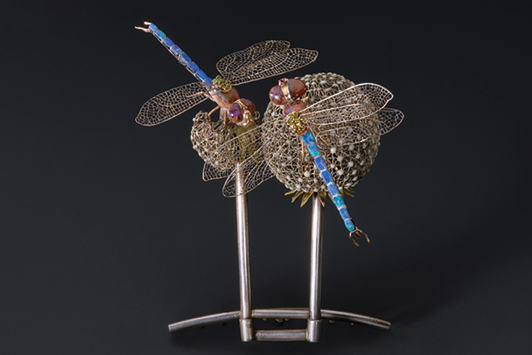
From diamonds to plastic, the Colonial period to contemporary creations, the collection of American jewelry at New York’s Metropolitan Museum of Art (the Met) spans the styles, materials and techniques that have played a part in the country’s ever-evolving jewelry industry.
Highlights of that collection make up the museum’s new “Jewelry for America” exhibition, which covers the nearly 300 years from 1730 to 2014. Jewelry accounts for most of the approximately 100 items on display, though the mix also includes paintings and works on paper that help further the narrative.
Costume jewelry and Native American jewelry are part of the exhibit as well. The latter category consists of several Zuni turquoise and coral necklaces, while the costume pieces include a Bakelite necklace and Kenneth Jay Lane cuffs based on the famous Verdura Maltese Cross bracelets.
“I thought it was important to tell [these stories] as well,” relates exhibition curator Beth Carver Wees, who serves as the Met’s Ruth Bigelow Wriston curator of American decorative arts. “One of the interesting things I realized was that while high-style jewelry influenced costume jewelry, sometimes costume jewelry helped popularize higher-end styles.”
The exhibition is divided into the following five sections:
1. Sentimental journey
This first area has the earliest pieces, dating from the 1730s and ’40s. It includes jewelry that immigrants either brought with them or ordered from England or Europe. These tended to be sentimental: mourning rings or brooches, love tokens, little rings with diamonds and other gemstones. There is a section on hair jewelry, which would memorialize a person who had either died or gone far away, such as a husband going to war. Sometimes the jewelry was made from the hair alone, but it might include a miniature portrait as well, with the hair inside or on the back.
Also in this section are hand-painted “eye miniatures, depicting a loved one,” says Wees, noting that these “were special, intimate gifts.” Similarly, cameos were popular in the 18th and 19th centuries as tributes to loved ones or as travel souvenirs.
Meanwhile, a painting by American artist John Bradley depicting a young girl with a coral necklace and bracelets illustrates the belief that wearing coral could protect children from harm.
2. American industry
Throughout the 19th century, the US continued to import jewelry, but manufacturing firms were developing domestically as well. Newark, New Jersey, was one of the early places where manufacturers set up in 1801. They made small things like collar buttons, but also diamond jewelry, according to Wees. American firms Gorham and Tiffany & Co. came on the scene in the 1830s.
“America was becoming mechanized and using steam-powered machinery,” explains Wees. “It’s also the period of the gold rush, the discovery of silver in Nevada, and the birth of the railroads.” By the early and mid-20th century, American jewelry makers were going their own way. “Jewelers such as Tiffany & Co. liked using native stones — Mississippi River freshwater pearls, Montana sapphires, tourmalines from Maine — making the pieces distinct from European jewelry.”
3. Fin de Siècle brilliance
With the discovery of diamonds in South Africa in the 1870s, a passion for diamond jewelry helped boost American-made pieces. Protective tariffs were another boon to American industry, since the steep levies placed on foreign goods restricted imports. The establishment of a Cartier branch in New York brought the ambience of French salons to the US, which new American jewelry houses sought to emulate. New York firm Dreicer & Co. produced elegant designs with diamonds, natural pearls and platinum.
Innovative touches caught on as well. In a late-19th-century corsage piece by Tiffany & Co., the three largest flowers unscrew to become separate brooches, using accompanying backings. And a diamond earring set from 1880 has snap-on covers, allowing a quick switch from a daytime to an evening look.
4. Nature and history as inspiration
At the turn of the century, says Wees, Art Nouveau was a powerful influence throughout Europe; in America, Louis Comfort Tiffany championed the style. Revivalist jewelry from firms like Marcus & Company and Theodore B. Starr, inspired by ancient Egyptian, medieval and Renaissance styles, was also popular. At about the same time, the Arts and Crafts movement, touting a return to handcraftsmanship, had begun in England and was taking hold in other countries. American jewelers followed suit, notes Wees, “including several women artists such as Florence Koehler, Margaret Rogers and Marie Zimmermann.”
5. Creativity and innovation
This final section includes the work
of mid-century modernists such as Alexander Calder, Sam Kramer, Art
Smith and Ed Wiener.
“The period from the Depression through World War II saw the use of less-precious materials such as copper and brass and plastic, as well as the rise of costume jewelry,” says Wees. “Women could continue to dress up but also be frugal. This last section segues to the jewelry of today, with works by William Harper, Mary Lee Hu, Thomas Gentille and Daniel Brush.”
Wees hopes visitors will come away with the sense “that over all of these 300 years, American jewelers, taking the global history of jewelry into account, used their skills and their intelligence to fashion styles for their American audience. Each of these pieces has a story to tell.”
Image: The Metropolitan Museum of ArtArticle from the Rapaport Magazine - July 2019. To subscribe click here.